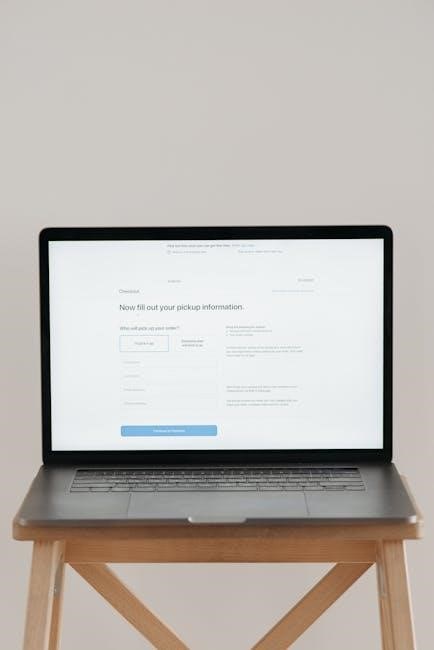Discover how Robert Kiyosaki’s groundbreaking book challenges traditional views on money and wealth. Available as a 336-page PDF, it offers insights into financial freedom and investing strategies.
Overview of the Book and Its Significance
Rich Dad Poor Dad, written by Robert Kiyosaki and Sharon Lechter, is a groundbreaking personal finance book first published in 1997. It explores the contrasting financial philosophies of two father figures: Kiyosaki’s real father (Poor Dad) and his mentor (Rich Dad). The book emphasizes financial literacy, investing, and wealth-building strategies, challenging traditional views on money and work. With its practical advice and real-life examples, it has become a bestseller, inspiring millions to rethink their approach to money. Available as a 336-page PDF, it remains a vital resource for anyone seeking financial freedom and understanding how to grow wealth effectively.

Background of the Author: Robert Kiyosaki
Robert Kiyosaki, born on April 8, 1947, in Hawaii, is a renowned entrepreneur, author, and motivational speaker. His experiences as a Marine Corps officer and salesman shaped his insights on wealth.
The Inspiring Journey of Robert Kiyosaki
Robert Kiyosaki’s journey is a testament to his resilience and entrepreneurial spirit. Born on April 8, 1947, in Hawaii, he faced early financial struggles, which shaped his determination to challenge traditional views on money. After serving in the Marine Corps, Kiyosaki ventured into various businesses, including a successful clothing company and later, real estate investments. His experiences with both successes and failures became the foundation of his teachings. Kiyosaki’s pivotal moment came with the publication of Rich Dad Poor Dad in 1997, which became a global phenomenon, inspiring millions to rethink their approach to wealth. His journey from financial adversity to becoming a motivational icon underscores his message of financial independence and self-empowerment.

Core Principles of “Rich Dad Poor Dad”
The book emphasizes financial literacy and transforming your money mindset. It advocates using money as a tool to build wealth through assets and creating multiple income streams.
Financial Literacy and Money Management

Financial literacy is the cornerstone of wealth-building in Rich Dad Poor Dad. The book teaches readers to view money as a tool for wealth creation, not just for earning. It emphasizes understanding how money works, rather than simply working for money. Key concepts include distinguishing between assets and liabilities and using debt wisely. Kiyosaki advocates for investing in income-generating assets and creating multiple income streams. He also stresses the importance of financial independence over traditional measures of success like a high salary. By mastering money management, readers can break free from the cycle of living paycheck to paycheck and build lasting wealth. This foundational knowledge is essential for achieving financial freedom.
Investing in Assets, Not Liabilities
Kiyosaki emphasizes the importance of distinguishing between assets and liabilities. Assets generate income, while liabilities drain resources. He advocates for investing in income-producing assets like real estate, businesses, and stocks, rather than buying liabilities masquerading as assets, such as expensive cars or large homes. This principle is central to building wealth and achieving financial independence. By prioritizing assets that produce cash flow, readers can create a sustainable path to prosperity. This mindset shift is a cornerstone of Kiyosaki’s philosophy, encouraging individuals to think differently about money and wealth accumulation.

The Two Dads: Contrasting Financial Philosophies
Robert Kiyosaki’s biological father (“Poor Dad”) and his best friend’s father (“Rich Dad”) represent opposing views on money: one emphasizes security, the other financial independence.
Poor Dad: The Traditional Approach to Money
Robert Kiyosaki’s “Poor Dad” exemplifies the conventional mindset, prioritizing job security and higher education. He believed in working hard, saving money, and avoiding financial risks. This approach often led to limited wealth and reliance on a steady paycheck. Poor Dad’s philosophy reflects societal norms, emphasizing stability over entrepreneurship and investment. His views contrast sharply with Rich Dad’s unconventional strategies, highlighting the tension between traditional employment and financial independence. This chapter explores how Poor Dad’s beliefs shaped Kiyosaki’s early understanding of money, emphasizing the importance of education and hard work but lacking in wealth-building strategies. His story serves as a cautionary tale about the limitations of traditional financial approaches.
Rich Dad: The Unconventional Path to Wealth
Rich Dad, Robert Kiyosaki’s mentor, introduced him to an unconventional approach to wealth. He emphasized financial literacy, investments, and building assets over traditional employment. Rich Dad taught that money should work for you, not the other way around. His philosophy encouraged taking calculated risks, understanding taxes, and leveraging debt wisely. Unlike Poor Dad, Rich Dad focused on entrepreneurship and creating income streams. His lessons transformed Kiyosaki’s mindset, urging him to pursue financial freedom through smart investments in real estate, businesses, and stocks. This chapter highlights how Rich Dad’s teachings empowered Kiyosaki to break free from the constraints of a paycheck and embrace a life of financial independence and prosperity.

Key Lessons from the Book
- Financial independence through assets and income streams.
- Money is a tool, not an end goal.
- Invest in income-generating assets, not liabilities.
- Manage risks and embrace continuous learning.
Understanding the Difference Between Assets and Liabilities
In Rich Dad Poor Dad, Robert Kiyosaki emphasizes the critical distinction between assets and liabilities. Assets generate income, such as rental properties or businesses, while liabilities drain resources, like personal loans or credit card debt. Kiyosaki stresses that true wealth is built by acquiring assets that produce cash flow, rather than accumulating liabilities disguised as assets, such as expensive cars or high-mortgage homes. This foundational concept shifts one’s mindset from merely earning money to creating systems that generate wealth. By focusing on asset acquisition, individuals can achieve financial freedom and escape the cycle of living paycheck to paycheck.
Building Multiple Income Streams
Robert Kiyosaki advocates for creating multiple income streams to achieve financial freedom. He distinguishes between active income (earned through a job) and passive income (generated through investments). By diversifying income sources, such as real estate, businesses, and paper assets, individuals reduce financial risk and increase stability. This approach contrasts with the traditional mindset of relying on a single paycheck. Building multiple streams ensures continuous cash flow, enabling wealth accumulation and independence. Kiyosaki’s philosophy encourages readers to think beyond conventional employment and invest in opportunities that yield long-term returns, ultimately leading to financial security and peace of mind.

Real-World Applications of the Book’s Teachings
Readers have applied Kiyosaki’s principles by launching businesses, investing in real estate, and diversifying income streams. Many credit the book for inspiring their financial independence and security.
Case Studies of Successful Financial Strategies
Many entrepreneurs and investors have adopted the principles from Rich Dad Poor Dad, achieving significant financial success. One notable case is a real estate investor who, inspired by the book, shifted focus from liabilities to assets, building a portfolio of rental properties. Another example is a young professional who diversified income streams by starting a side business and investing in dividend-paying stocks. These success stories highlight how Kiyosaki’s teachings on financial independence and wealth-building have empowered individuals to transform their financial lives. The strategies outlined in the book, such as minimizing debt and maximizing passive income, have proven effective for many readers seeking financial freedom.
How Readers Have Applied the Concepts
Readers of Rich Dad Poor Dad have taken actionable steps to transform their financial lives. Many have shifted focus from earning a paycheck to building assets, such as real estate investments or businesses. Others have diversified income streams by starting side hustles or investing in stocks and bonds. The book’s emphasis on financial literacy has inspired individuals to improve their money management skills, reduce debt, and increase savings. By applying Kiyosaki’s principles, readers have achieved greater financial independence and confidence in their ability to grow wealth. The practical advice has empowered many to take control of their financial futures and pursue long-term prosperity.

The Importance of Financial Education
Financial education empowers individuals to make informed decisions, escape the income trap, and build sustainable wealth, aligning with the principles outlined in Rich Dad Poor Dad.
Why Schools Don’t Teach Financial Literacy
Schools often prioritize core subjects like math, science, and literature over financial literacy, leaving many without essential money management skills. This gap fosters financial struggles, emphasizing the need for alternative resources like Rich Dad Poor Dad to fill the void.
Empowering Yourself Through Knowledge
Financial literacy is a powerful tool for achieving independence and prosperity. Rich Dad Poor Dad emphasizes that knowledge is the key to breaking free from financial limitations. By understanding how money works, individuals can make informed decisions about investing, saving, and building wealth.
The book encourages readers to take control of their financial education, as traditional schooling often neglects this critical area. Accessing resources like the 336-page PDF of Rich Dad Poor Dad provides a foundation for transforming one’s relationship with money and securing a brighter financial future.

How to Download “Rich Dad Poor Dad” Safely and Legally
Download the 336-page PDF legally from authorized platforms like Amazon or Z-Library. Avoid pirated copies to support authors and ensure a safe, high-quality reading experience.
Authorized Platforms for PDF Downloads
Access the 336-page PDF of “Rich Dad Poor Dad” through reputable platforms like Amazon Kindle, Z-Library, and Plata Publishing. These sites ensure legal and secure downloads, supporting authors and providing high-quality formats. Always verify the source to avoid unauthorized copies. Legal downloads protect intellectual property and offer a seamless reading experience. Choose platforms with positive reviews and secure payment options for a safe and reliable download process.
Avoiding Pirated Copies and Supporting Authors
Pirated copies of “Rich Dad Poor Dad” harm authors and often contain low-quality content. To support Robert Kiyosaki, purchase the 336-page PDF from authorized platforms like Amazon Kindle or Z-Library. These sites offer secure, high-quality downloads, ensuring your access to the book is legal and risk-free. Avoid illegal downloads to respect intellectual property and avoid potential legal consequences. By choosing legitimate sources, you contribute to the sustainability of authors and the publishing industry. Always verify the authenticity of the platform before downloading to ensure a safe and ethical reading experience.
Robert Kiyosaki’s book teaches financial literacy, investing in assets, and building income streams. It contrasts two dads’ philosophies, emphasizing wealth-building strategies for financial independence and success.
Transforming Your Mindset About Money
Rich Dad Poor Dad revolutionizes how people think about money. It encourages readers to view money as a tool for wealth creation rather than just earning a paycheck. The book emphasizes financial literacy and understanding the difference between assets and liabilities. By adopting this mindset, individuals can break free from the cycle of living paycheck to paycheck and instead focus on building passive income streams. The key takeaway is to invest in assets that generate income, such as real estate or businesses, rather than accumulating liabilities like expensive cars or credit card debt. This shift in perspective is crucial for achieving long-term financial freedom and security.

Practical Steps to Achieve Financial Freedom
Robert Kiyosaki outlines actionable strategies to attain financial independence. Start by increasing your income through assets, not just a salary. Manage expenses wisely and invest in income-generating assets like real estate or businesses. Avoid debt and focus on building multiple income streams to reduce financial risk. Educate yourself on money management and market trends to make informed decisions. The book encourages taking calculated risks and leveraging compound interest. By following these steps, readers can break free from the cycle of earning and spending, creating a path to lasting wealth and financial security.
Since its release in 1997, “Rich Dad Poor Dad” has revolutionized financial thinking worldwide. Its practical advice on wealth creation and financial independence continues to inspire millions. The book’s emphasis on financial literacy, asset accumulation, and entrepreneurship has reshaped how people view money. Available as a free PDF download spanning 336 pages, its accessibility has further amplified its influence. Readers have applied its principles to build wealth, escape the paycheck cycle, and secure their financial futures. Robert Kiyosaki’s teachings remain a timeless guide for anyone seeking to transform their financial lives and achieve true freedom.










